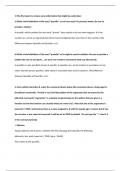Exam (elaborations)
MATH 1280 Assignment Unit 6- University of the People
- Course
- Institution
MATH 1280 Assignment Unit 6- University of the PeopleMATH 1280 Assignment Unit 6- University of the PeopleMATH 1280 Assignment Unit 6- University of the PeopleMATH 1280 Assignment Unit 6- University of the PeopleMATH 1280 Assignment Unit 6- University of the PeopleMATH 1280 Assignment Unit 6- Unive...
[Show more]



